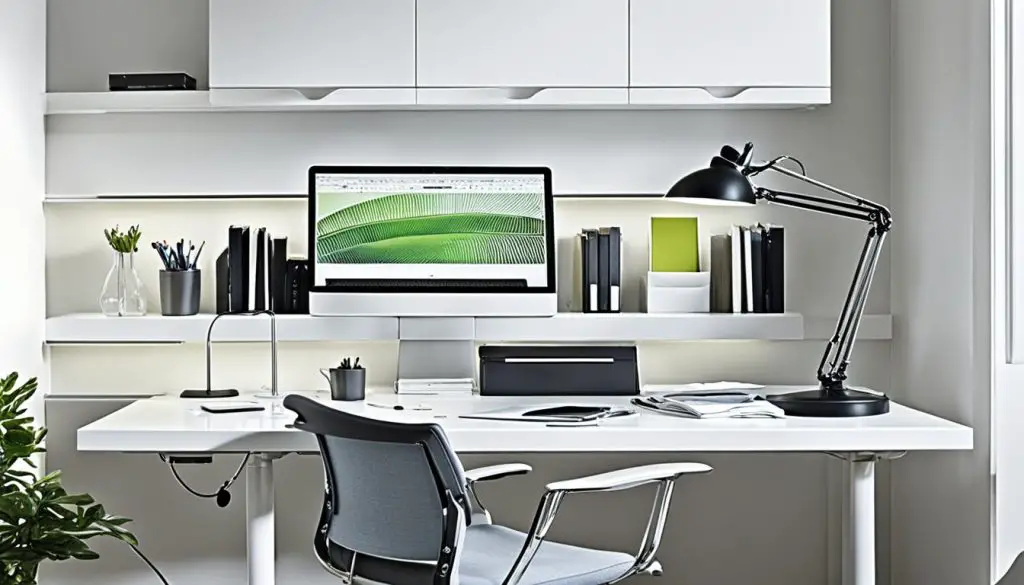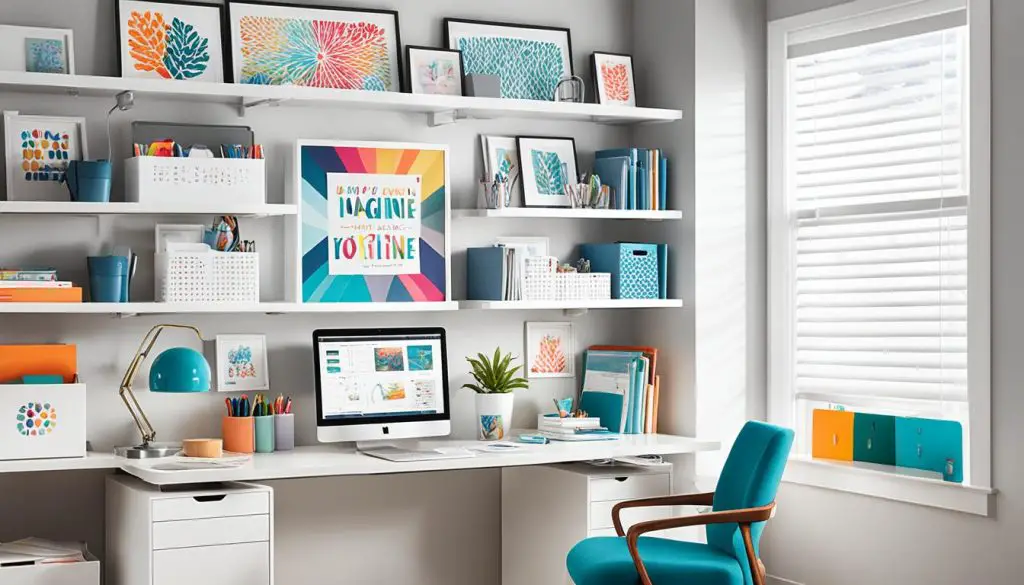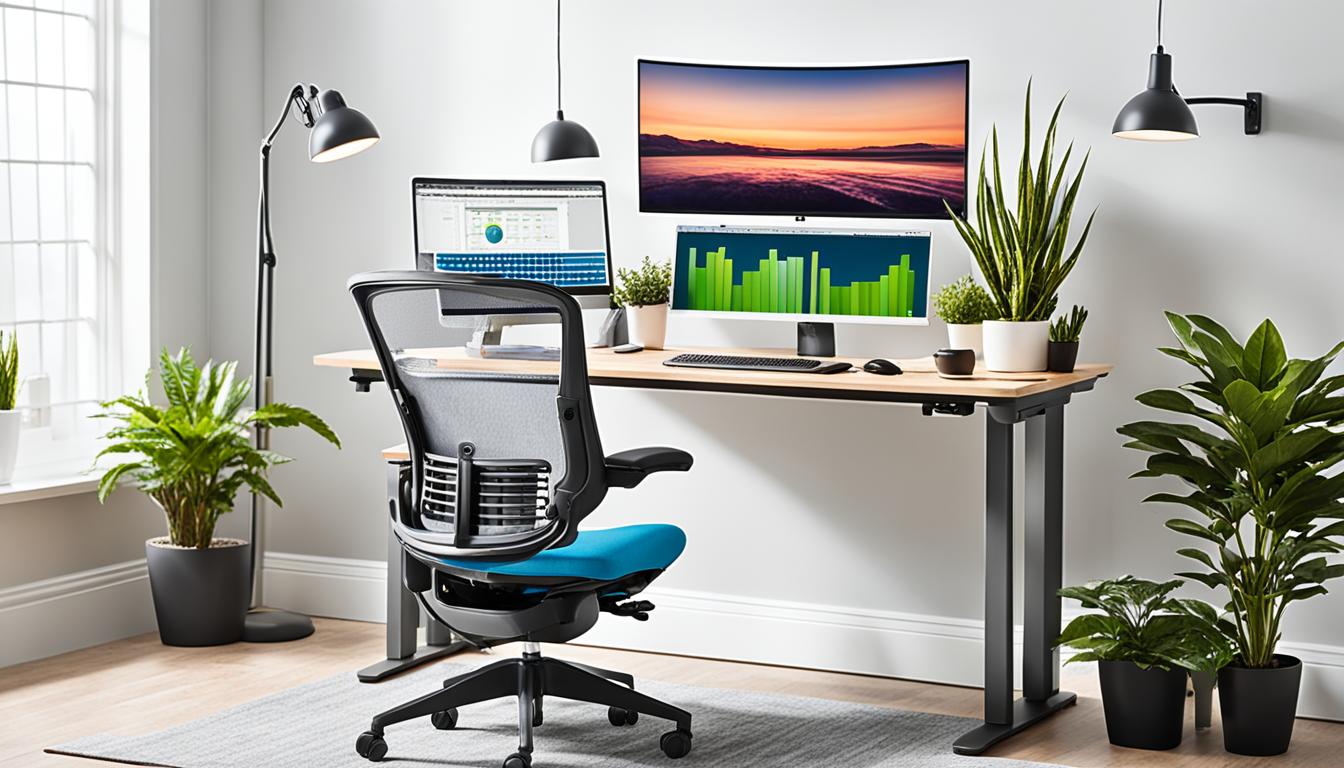Living with a chronic illness has shown me the value of an ergonomic home office. It boosts my work output, helps manage pain, and improves my overall health. But, setting up a workspace that makes you efficient and supports your body is key. Let’s look at how you can customize your home office for your chronic condition.
A chronic illness can change everything about your daily life. This includes how you work, your relationships, and more. Staying at home might become necessary, but it requires your home to be fit for your specific needs.1 Designing your home for a chronic illness means tailoring it to your needs now and in the future. It’s more than following disability laws. It’s about managing pain, fitting in assistive devices, and creating a calm place that helps your physical and mental health.
Importance of an Ergonomic Home Office Setup
Some people need to stay home due to health issues. It helps them get the care they need while feeling comfortable and happy. Yet, many homes aren’t set up for this, especially for those with disabilities or health problems. An ergonomic home office setup is key for them.2
This setup uses special ergonomic furniture and ideas to reduce pain and fatigue. It also increases productivity and comfort. Chairs, adjustable standing desks, and adaptive equipment are essential. They improve posture, lower body stress, and help you move better during work.3
Alleviating Pain and Fatigue
Adding things like low-light plants, soft lighting, and comfy seats to your office helps too. This can make you feel physically and mentally better.2
Boosting Productivity and Comfort
Focusing on an ergonomic home office setup does wonders for people with health issues. It helps cut down on pain and tiredness, and it boosts productivity and comfort.2
Adjustable Standing Desks for Versatility
Adjustable standing desks are changing the game for people with chronic health issues. They offer the flexibility to move and change posture. This is crucial for improving comfort and reducing the strain from sitting too long.
They let users switch easily between sitting and standing. This is great because it means different people can find the best desk height for them. This supports their unique needs, making sure they are comfortable and avoid unnecessary physical stress.
Changing the desk’s height also helps keep a good posture. This is key for preventing muscle aches, back pain, and other problems. Plus, standing up and moving during the day can make you feel more alert and healthier both in body and mind.
Promoting Movement and Posture Variety
Being able to stand and sit as needed is good for everyone, especially those with chronic illnesses. With an adjustable standing desk, they can avoid the discomfort from prolonged sitting.4 It lets them set the desk to their ideal height. This supports their body well and keeps them in a good posture state.
Accommodating Different Heights and Needs
Adjustable standing desks fit people of all sizes and needs. They are perfect for those dealing with ongoing health issues. By adjusting the desk just right, these users can work comfortably without risking their health.
This flexibility ensures a comfortable workspace for people with different health challenges. It helps them concentrate on their tasks despite their health problems.
Ergonomic Chairs: A Game-Changer for Back Support
For folks with chronic issues, the right ergonomic chairs can change everything. They help with back support and chronic pain. Experts say a good ergonomic office chair for back pain must be really adjustable. This includes customizing lumbar support, how much you can recline, and more. For instance, the TEMPUR-Pedic TEMPUR-Lumbar Support Office Chair has a shaped seat and a mesh back. These parts fit your body, ease pressure, and keep your spine’s natural shape.5 Being able to adjust back and arm support helps people find the right comfort and alignment. This reduces their back pain now and avoids future problems.5 So, buying a top-notch, adjustable ergonomic chair is a big plus for anyone working from home with chronic issues.
The TEMPUR-Pedic TEMPUR-Lumbar Support Office Chair stands out. Its form-fitting seat and breathable back give the back support and relief needed for chronic pain. You can tweak the lumbar support and more on this ergonomic chair. This feature is key for fighting discomfort and stopping new pains. That’s why it’s such a good choice for a home office.
Adaptive Equipment and Assistive Technology
Adding adaptive equipment and assistive technology boosts a home office’s use for those with chronic illnesses. For example, voice-controlled devices let you do tasks without using your hands. They make it easier for people with low mobility or dexterity to work. Keyboards and mice with special features can help those using fine motor skills too.6
Voice-Controlled Devices for Hands-Free Operation
This tech lets individuals set up their workspace for better productivity. It’s key for folks whose abilities change due to ongoing health issues.6
Specialized Keyboards and Mice
Special keyboards and mice assist folks needing better input options for fine motor skills. These tools offer comfort and efficiency to those users.6
Best Furniture Chronic Illness Home Office
To create the top chronic illness home office, focus on furniture that promotes comfort and eases pain. Essential items are adjustable standing desks and chairs with great back support.1 These also include tools that fit the user’s unique needs.
Investing in quality custom furniture and helpful devices can make a big difference. They can help lessen the physical stress of a chronic illness. Plus, they boost how much work you can do and how you feel overall.1 When picking furniture, think about your health challenges and what you need for your lifestyle. This ensures you get the best set up for your home office.

Creating a Comfortable and Soothing Environment
A home office should not only be efficient but also comforting, especially for those with ongoing health issues.7 The choice of low-light plants, like snake plants, can improve the air and bring nature closer.7 Adding a serene color palette and adjustable lighting will lessen strain on the eyes and enhance calmness in the area.7 This approach helps in making the work area a haven for people living with chronic conditions, aiding in both their job commitment and health management.
Low-Light Plants for Natural Air Purification
Snake plants or pothos are excellent for enhancing the atmosphere of a home office for those with chronic illnesses.7 Not only do these plants clean the air naturally but they also introduce a peaceful ambiance.7 Their ability to thrive in low light makes them perfect for areas without much sunlight. Employing these types of plants can lead to a more serene and healthier work space, benefiting both mood and work performance.
Calming Color Schemes and Soft Lighting
The combination of greenery, calming colors, and adjustable lighting fosters a tranquil state in the home office for those needing special care.7 Choosing soft, neutral shades for the area minimizes visual distractions and supports calm.7 Having lights that can be dimmed adds another layer of customization to reduce stress on the eyes.7 Such a design helps those with chronic diseases by providing a healing environment, easing both physical and emotional stress they may face daily.
Accessible Furniture for Mobility Challenges
Those with mobility problems can benefit greatly from accessible furniture. Lift chairs are a prime example. They aid in moving from siting to standing positions with ease. This helps avoid extra strain on those with movement challenges.8
Another great piece is an adjustable bed. It lets you change the bed’s height to fit your needs. For those working from home, it means adjusting easily to a working position or a relaxing one.8
These furniture items keep people with limited movement independent. They support work or rest activities in a comfortable way. This is crucial for those facing ongoing health challenges.8
Lift Chairs for Easy Transition
Lift chairs make sitting and standing easy for those with less mobility. These chairs lift and lower smoothly. They help moving around the home office a lot smoother.8
This simple inclusion in a home office can make a big difference. It supports independence and helps people work more comfortably. This way, their health condition doesn’t worsen from daily activities.
Adjustable Bed for Resting and Working
An adjustable bed is another valuable piece. It transforms from a relaxing to a work spot. This means no need for extra furniture for work or rest. It’s an all-in-one solution for those who need it.8
Having this bed in a home office keeps productivity high. At the same time, it keeps health concerns in check. It’s a win-win for individuals with mobility challenges working from home.
Chronic Pain Management Through Furniture Design
For those coping with chronic pain, the design of their furniture matters a lot. It can make a big difference in how they feel and their health.9 Chronic pain takes a toll not just physically, but emotionally and socially too.9 It includes issues like fibromyalgia, osteoarthritis, and ongoing back pain.9
Pressure-Relieving Cushions and Supports
Adding cushions and supports to chairs, desks, and beds is key. They help ease pressure and make sitting or lying down more comfortable.9 Chronic pain is a type of pain that goes on for more than 3 months. It’s seen in conditions like fibromyalgia and arthritis.9
Massage Chairs for Relaxation and Rejuvenation
Having massage features in furniture is a great idea. It can bring a sense of calm and renewal to your space.9 Many chronic diseases can cause pain, like diabetes and heart issues.9 Designing furniture with this in mind transforms your home office. It becomes a place to get relief from pain, keep up your work, and stay focused.
Maximizing Space and Organization
Making the most of your home office can really boost how you feel and work. Adding space optimization and organization is key. Modular and multifunctional furniture is perfect. Furniture like desks with storage or chairs with worktops built in, save space. They also change to fit your needs.9
Modular and Multifunctional Furniture
Using smart storage solutions cuts down on mess. It makes your office feel peaceful and neat.9 Welling up the layout and storage helps keep stress low. This improves how well you can focus. It also helps you keep a handle on things, especially when health issues are a concern.
Storage Solutions for Decluttering
Focusing on space optimization and organization turns your home office into a great place to work. It helps you do well even with chronic illness challenges.9

Considerations for Specific Chronic Illnesses
Designing a home office for chronic illnesses involves thinking about each person’s needs. Those with arthritis need special furniture and tools. These help avoid joint pain and make moving easier1. Things like adjustable countertops and appliances are good. They cut down on bending. Also, adding non-slip floors and grab bars makes the space safer1.
Arthritis-Friendly Furniture and Accessories
People with arthritis should have furniture that makes working easier. For them, adjustable items and tools are a must. These reduce the strain on joints. Grab bars also help by adding steadiness. This setup lowers the chances of accidents. Using special kitchen tools and devices can also be a big help for daily activities1.
Furniture for Neurodegenerative Conditions
Those with neurodegenerative diseases, like Alzheimer’s, need extra safety measures. Home offices for them should have smart features and lots of light. This lowers the risk of injuries and wandering1. It’s also helpful to make the outside of the home distinct. This makes it easier for people with memory issues to find their way home1.
Taking these steps makes the home office a better place for those with chronic illnesses. It allows for independence and care. Plus, it improves their quality of life overall.
Budgeting and Cost-Effective Solutions
Setting up a home office for managing a chronic illness can be costly. Yet, you can reduce expenses by prioritizing budget-friendly solutions. Start with key items like an adjustable desk, a good chair, and any needed assistive tools. Focusing on these essentials first ensures you build a workspace that supports your health and work.10
Prioritizing Essential Pieces
When designing a home office for a chronic condition, choose and invest in key furniture and tools. Consider the Flash Furniture Kelista Chair, which costs $191.79 and holds up to 250 pounds,10 or the Serta Works Chair at $396.99 and the same weight limit.10 Picking these foundational items helps create a comfortable work environment.
Finding Quality Used Furniture
Finding used furniture can also save you money. Sites like OfferUp and Facebook Marketplace sell budget-friendly chairs and desks. You can get chairs, like the Modway and Etta Avenue, at big discounts. Being smart in your search can lead to a nicely equipped, affordable workspace.
By starting with must-have items and looking for secondhand deals, you can set up a home office that supports your health and budget. This method lets you focus your money on what really matters. It ensures you have a space conducive to working well, even with a chronic illness.
Personalizing Your Chronic Illness Home Office
Customizing the chronic illness home office goes beyond just making it work well. Adding elements that show the person’s hobbies, interests, and style makes it a space they love. This brings comfort, inspiration, and a motivation boost.9
Incorporating Hobbies and Interests
Showing off art, setting up favorite hobbies, or keeping meaningful items close brightens the workspace.9 By filling the room with what you love, your home office becomes a personal haven. This feeds your well-being and creativity, helping both your body and mind.
Creating a Positive and Motivating Space
It’s also key to keep work and personal areas separate, and to take regular breaks. These steps aid in keeping a good work-life balance, preventing burnout, and managing a chronic illness.9 A workspace that inspires and uplifts you can boost productivity and maintain focus. It’s important for your mental and physical health, letting you effectively deal with your condition.
Source Links
- https://liveinplacedesigns.com/how-home-design-can-help-you-live-with-a-chronic-illness-or-condition/
- https://www.breakfastleadership.com/blog/the-importance-of-ergonomics-in-a-home-office
- https://www.mayoclinic.org/healthy-lifestyle/adult-health/in-depth/office-ergonomics/art-20046169
- https://www.techradar.com/news/best-standing-desk
- https://apnews.com/buyline-shopping/article/best-office-chair-for-back-pain
- https://creakyjoints.org/living-with-arthritis/best-selling-assistive-devices/
- https://www.boulderhomesource.com/wfh-office-design-guide/
- https://www.homeadvisor.com/r/making-home-offices-more-accessible-for-disabilities/
- https://www.julieannrachelle.com/blended-decor-blog/wellness-design-for-chronic-illness
- https://time.com/shopping/article/best-budget-office-chairs/
